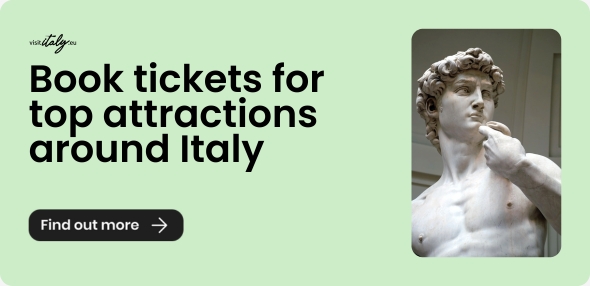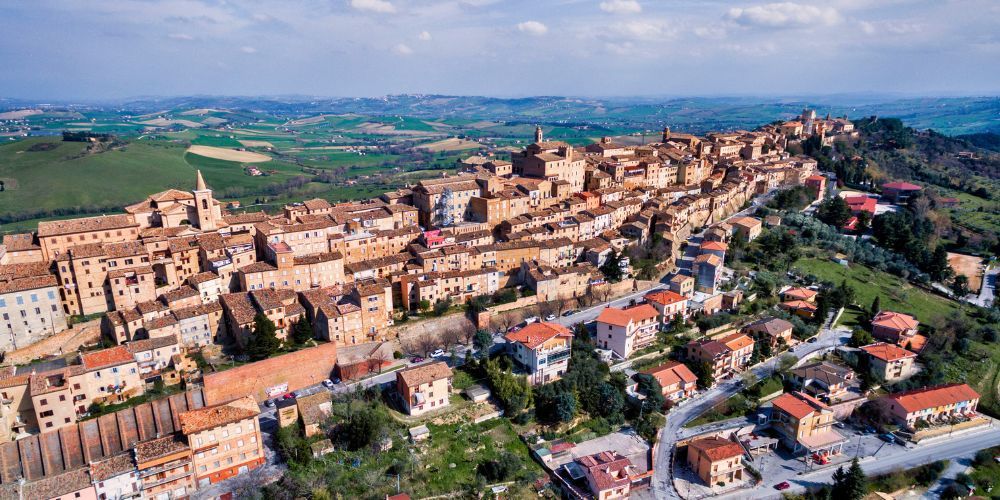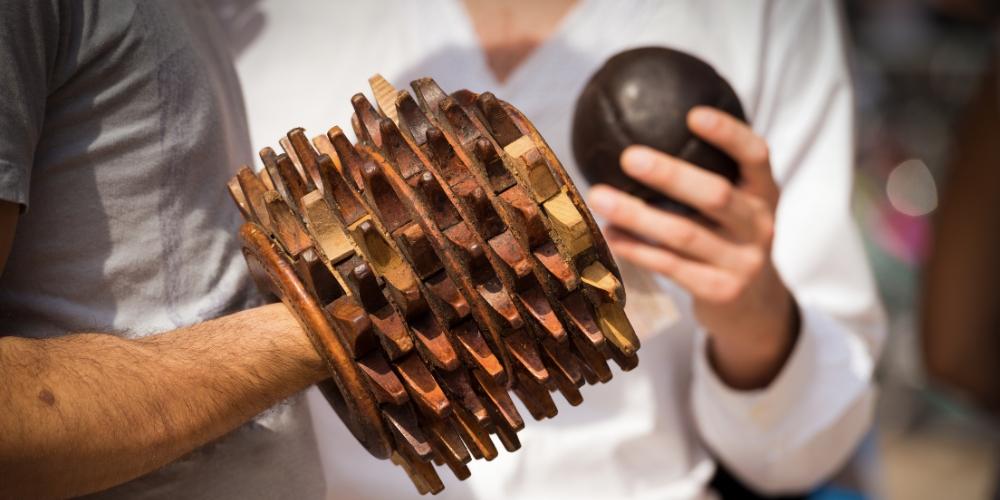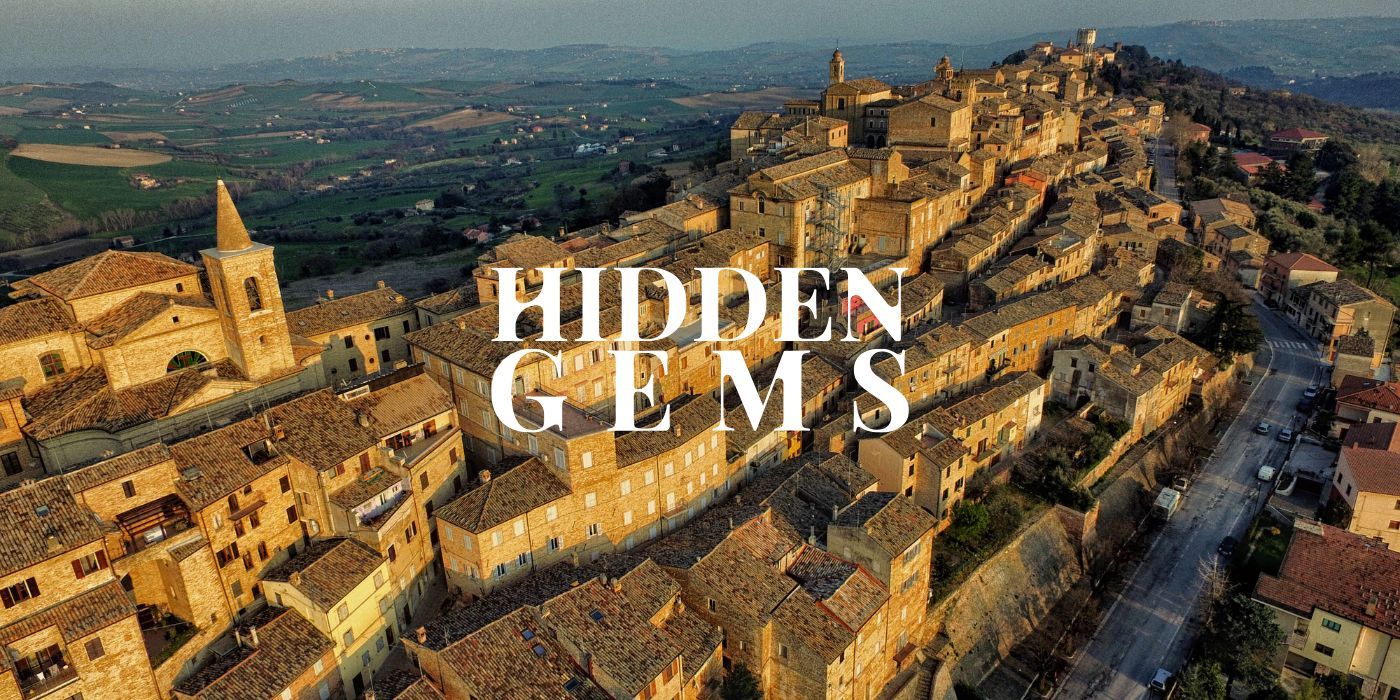Less than 20 kilometres from Macerata there lies Treia, a lovely town with a pretty historic centre, an impressive panoramic terrace where views overlook both Adriatic Sea and Sibillini Mountains, many artistic and cultural glimpses and a particular sports tradition.
Treia is indeed home to the game of bracelet ball, the ancient national sport - once as popular as football today - also known affectionately as the Italian quidditch. And just like the famous wizarding game in the Potter series, the bracelet ball is also a symbol of an alternative, distant world, but that magically revives again every year with the Disfida.
But in Treia you can also savour the taste of the most authentic Marche life, a genuine atmosphere to breathe while walking through the village streets just like sitting at a restaurant table. Indeed, local cuisine is marvellously surprising: its undisputed protagonist is calcione, the traditioanl puff pastry filled with cheese, a must try for true connoisseurs.
Are you tempted to join us? Then continue reading and discover what to see in Treia, the magical town that will captivate you.

What to see in Treia: let's begin exploring the village

There are seven gates along the medieval walls. The city symbol, an imponent document of the time when Treia was still called Montecchio, is not far from Porta Palestro. The San Marco Tower is a scenic 12th-century crenellated turret that is the only 'survivor' of an ancient castle named after a Longobard princess, Onglavina.
Treia sits on a hill overlooking the valley of the Potenza river, which it colours with the soft amber shades of its buildings. The village's cobbled streets side with churches and sober elegant houses, small squares, panoramic views and narrow alleys, key features of every medieval hamlet.
Among the most exciting points of interest is the Teatro Condominiale, which you reach by walking along the carvings and bas-reliefs that frame Corso Italia Libera. The richly decorated 19th-century theatre features a unique curtain evocative of the town's history.
In 1865, Silverio Copparoni depicted the Battle of Vallesacco, a well-known clash between the Montecchio's castle and Corrado d'Antiochia that took place in 1263 at Porta Vallesacco, one of the entrances to the historic centre of Treia.
What to see in Treia: let's visit the village's top attractions

While Piazza della Repubblica is the most renowned corner of Treia, and we will check it out later on, but for sure this village does not lack of plenty of top attractions to visit.
In contrada San Marco Vecchio, a majestic oak tree was declared a national monument in 2000. That's Treia's Roverella, about 450 years old and 20 metres tall.
In the hamlet of Passo di Tria rises Torre del Mulino. The tower, a small quadrangular defensive fortress for the mill within, dates back to the 14th century.
Villa Spada, also known as Villa La Quiete, is among the most beautiful historic residences in the Marche region. A jewel of neoclassical architecture by Giuseppe Valadier, it can be visited by appointment.
In contrada Fontevannazza, just outside the town, stands a 19th-century rural house made of unbaked earth, a rare example of humble and elementary construction widespread around the Abruzzo and Marche regions.
The gothic church of San Francesco and the related convent, which houses the Civic Archaeological Museum with its collection of Egyptian and Roman artifacts that witness the 'exotic' cult of the divinities Isis and Serapis around Treia area.
Not to be missed also the majestic sanctuary of Santissimo Crocifisso that preserves a 15th-century crucifix attributed to Donatello.
Need more tips about what to see in Treia? Then you should definitely check out Marche Tourism, but please wait to click as our journey is still ongoing.
Treia and its main spot: check out Piazza della Repubblica
Piazza della Repubblica is Treia's 'living room'. This ample horseshoe-shaped square opens on a panoramic terrace, with a view embracing Mount Conero and the Adriatic Sea. It's no surprise that it's one of author Dolores Prato's favorite places.
What catches the eye the most is the 18th-century marble balustrade, a stunning balcony over the fields and hills of the Marche region.
La piazza is the beating heart of Treia and boasts several valuable architectural and artistic elements. The beautiful blue marble fountain in the centre is surrounded on three sides by the Church of San Filippo Neri, the Palazzo Comunale, home to the Civic Museum, and the Accademia Georgica.
The latter, an 18th-century building by Valadier, keeps 14.000 books and houses the Municipal Historical Archives, maybe the oldest and most well-stocked in Le Marche.
Just a few steps away, the shining church Santissima Annunziata, Treia's own cathedral, with its artistic treasures such as the altarpiece by Giacomo da Recanati.
Treia and Italian quidditch: check out bracelet's Disfida

An ancient sport so popular in Italy until the beginning of the 20th century, based on the challenge between the four districts of Treia, that are Vallesacco, Onglavina, Borgo and Cassero.
The bracelet ball game is the symbol sport in town, a practice that reminds of Harry Potter's quidditch (interestingly, even at Hogwarts four teams join the tournament!) and that has survived the centuries and changes in customs, habits and passions.
Carlo Didimi was its spokesman and most famous and celebrated player (even by the great poet Giacomo Leopardi). Treia's arena sferisterio is dedicated to this kind of bracelet's ball Lionel Messi and annually hosts the so-called Disfida del Bracciale.
It's a national bracelet ball tournament, somewhere between a sporting event and a historical commemoration. The event occurs after ten days of celebrations between July and August in a colourful succession of shows, music and entertainment to revive the past of Treia with truy joyful vibes.
Inevitably, a place that so proudly carries on its traditions cannot miss a museum honouring the sport the town is so fond of: the Bracelent Ball Game Museum, a temple for this sport set up with photos, posters, trophies, cups, armbands and balls from the 19th century to the present day.
How to get to Treia

Let's finally find out how to get to Treia and visit the magical Italian village of quidditch. You have different options to pick; you can reach Treia by train (the nearest station is Macerata), by bus or by your own vehicle. Let's find out how to do this specifically.
When travelling by bus or train, the best way to get to Treia is to reach Macerata first and then continue by taxi or via the Contram bus line.
If you travel by car and want to get to Treia from north, take the A14 Bologna-Bari motorway toward Ancona. Exit at Ancona Nord, follow the direction for Rome and exit at Jesi Centro. Drive through Filottrano and continue to Treia, following the signs.
From the south, take instead the A14 towards Napoli and exit at Civitanova Marche. Then follow signs for Tolentino/Macerata, exit at Macerata Ovest - Sforzacosta, continue towards Macerata, cross Sforzacosta and continue towards Treia.
Were these information helpful? Get ready for a truly special day trip to the heart of the Marche region and browse our guides on what to do and what to see in Treia to enjoy a truly exciting travel experience!
About the author
Written on 30/12/2022



Lorena Calise
Find out what to do and what to see in Treia, a village of beauty, flavors and yesteryear sports within the green hills of Marches near Macerata.